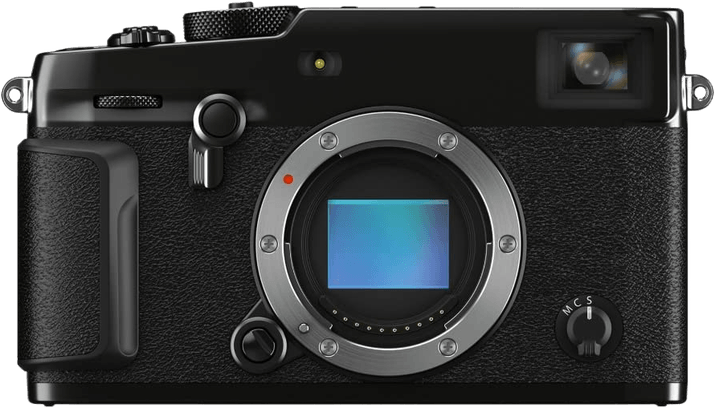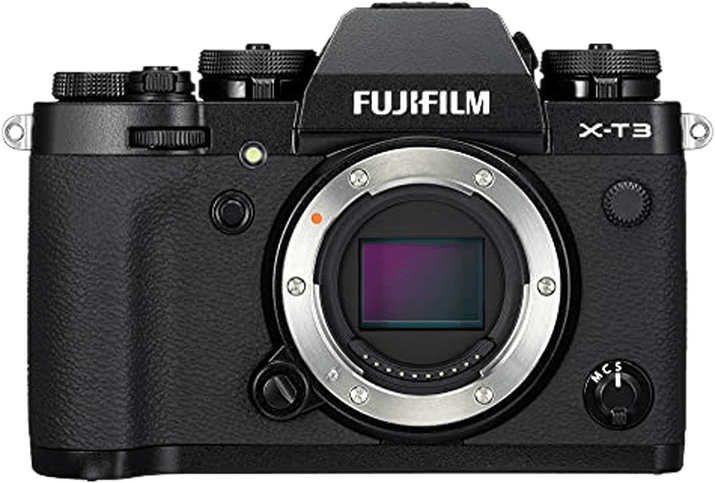Fujifilm X-Pro3 vs X-T3 Comparison
Fujifilm X-Pro3

Fujifilm X-T3

The Fujifilm X-Pro3 and Fujifilm X-T3 both receive a score of 72/100, indicating their comparable quality. As mirrorless cameras, they share some common specifications. Both were released in the late 2010s, with the X-Pro3 in 2019 and the X-T3 in 2018. The X-Pro3 is the more expensive option, with a launch price of $1799, compared to the X-T3’s $539.
In terms of size and weight, the X-Pro3 is slightly smaller and lighter, measuring 141 x 83 x 46mm and weighing 497g. The X-T3, on the other hand, measures 133 x 93 x 59mm and weighs 539g. This makes the X-Pro3 more portable and easier to handle.
Despite the higher price, the Fujifilm X-Pro3 offers advantages in size and weight. The Fujifilm X-T3, however, is the more affordable option while still offering similar performance. Both cameras are great choices for mirrorless camera enthusiasts, with the selection ultimately depending on personal preferences and budget.
Fujifilm X-Pro3 vs X-T3 Overview and Optics
The Fujifilm X-Pro3 and Fujifilm X-T3 share the same score of 67/100 for optics, indicating that both cameras have similar optical capabilities. They have many common specifications, including 26 megapixels, a CMOS sensor, the X-Processor 4, APS-C sensor size, Fujifilm X lens mount, and no image stabilization. The similarity in these specifications suggests that both cameras can produce high-quality images with the same level of detail and color accuracy.
However, the Fujifilm X-T3 has a faster shooting speed of 20fps compared to the X-Pro3’s 11fps. This advantage allows the X-T3 to capture fast-moving subjects more effectively, making it a better choice for action and sports photography.
On the other hand, the Fujifilm X-Pro3 does not have any specific advantages over the X-T3 in terms of optics. Therefore, the X-T3’s superior shooting speed makes it a better choice for photographers who require rapid continuous shooting capabilities.
Both cameras provide excellent optical performance, and their shared specifications ensure that image quality is top-notch. The Fujifilm X-T3 holds a slight edge due to its faster shooting speed, making it more suitable for action photography. However, the Fujifilm X-Pro3 remains an excellent choice for photographers who do not require rapid continuous shooting capabilities. Ultimately, the decision between the two cameras should be based on individual preferences and specific photography needs.
Fujifilm X-Pro3 vs X-T3 Video Performance
The Fujifilm X-Pro3 outperforms the Fujifilm X-T3 in video capabilities, with a score of 91/100 compared to the X-T3’s 83/100. Both cameras share common features such as 4K max video resolution and 4096 x 2160 max video dimensions. Additionally, they both have built-in time-lapse functionality.
The X-Pro3 stands out with its higher max video frame rate of 120fps, which is double the X-T3’s 60fps. This allows for smoother, more detailed slow-motion footage and better overall video quality. The increased frame rate makes the X-Pro3 more versatile for videographers who require crisp and fluid motion in their videos.
On the other hand, the X-T3 does not offer any significant advantage over the X-Pro3 in terms of video performance. Both cameras have similar video specifications, except for the difference in the max video frame rate. The X-T3’s lower score reflects its lower frame rate and not any additional features or capabilities.
In comparing the video capabilities of the Fujifilm X-Pro3 and X-T3, it is evident that the X-Pro3 is the superior choice. Its higher score of 91/100 reflects its better performance, particularly in terms of its higher max video frame rate. Meanwhile, the X-T3 does not provide any notable advantages over the X-Pro3. Videographers seeking the best possible performance should choose the Fujifilm X-Pro3 for its superior video capabilities.
Fujifilm X-Pro3 vs X-T3 Features and Benefits
The Fujifilm X-Pro3 emerges as the winner with a feature score of 85/100, while the Fujifilm X-T3 follows closely behind with a score of 83/100. Both cameras share several specs, including a 3-inch screen size, touchscreen capabilities, flip screen, GPS absence, and built-in WIFI and Bluetooth.
The X-Pro3’s superiority lies in its screen resolution, boasting 1,620,000 dots compared to the X-T3’s 1,040,000 dots. This difference results in a sharper and clearer image display, allowing for better composition and review of captured images.
The X-T3, however, does not fall far behind and still offers several benefits. Its feature score of 83/100 is only slightly lower than that of the X-Pro3, demonstrating that it is a highly capable camera. While it may not have the same screen resolution as the X-Pro3, the X-T3 still delivers an impressive image display with its 1,040,000 dots.
Considering the feature scores and shared specifications, both the Fujifilm X-Pro3 and X-T3 are excellent cameras. The X-Pro3 stands out with a higher screen resolution, providing a better image display experience. On the other hand, the X-T3 remains a strong contender with its slightly lower feature score, showcasing that it is a solid camera choice. Ultimately, photographers should weigh the importance of screen resolution in their work when deciding between these two cameras.
Fujifilm X-Pro3 vs X-T3 Storage and Battery
The Fujifilm X-Pro3 wins in the storage and battery category with a score of 71/100, while the Fujifilm X-T3 scores slightly lower at 68/100. Both cameras share the same battery type, NP-W126S, and have USB charging capabilities. They also have two memory card slots each, accepting SD, SDHC, and SDXC cards. However, the X-Pro3 has an advantage with UHS-II compatibility for faster read and write speeds.
The X-Pro3’s battery life is slightly better, offering 400 shots per charge compared to the X-T3’s 390 shots. This difference, though small, gives the X-Pro3 an edge in terms of shooting duration. The X-T3 does not have any clear advantages in the storage and battery category.
Based on these specifications, the Fujifilm X-Pro3 is the superior choice for those prioritizing storage and battery performance. Its UHS-II compatibility and marginally longer battery life make it a more reliable option for extended shooting sessions.
Fujifilm X-Pro3 vs X-T3 – Our Verdict
Are you still undecided about which camera is right for you? Have a look at these popular comparisons that feature the Fujifilm X-Pro3 or the Fujifilm X-T3:

